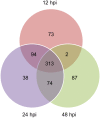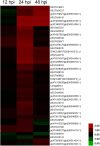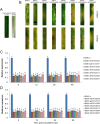Quantitative Proteomics Reveals the Defense Response of Wheat against Puccinia striiformis f. sp. tritici
- PMID: 27678307
- PMCID: PMC5039691
- DOI: 10.1038/srep34261
Quantitative Proteomics Reveals the Defense Response of Wheat against Puccinia striiformis f. sp. tritici
Erratum in
-
Corrigendum: Quantitative Proteomics Reveals the Defense Response of Wheat against Puccinia striiformis f. sp. tritici.Sci Rep. 2016 Dec 22;6:38464. doi: 10.1038/srep38464. Sci Rep. 2016. PMID: 28004734 Free PMC article. No abstract available.
Abstract
Wheat stripe rust, caused by Puccinia striiformis f. sp. tritici (Pst), is considered one of the most aggressive diseases to wheat production. In this study, we used an iTRAQ-based approach for the quantitative proteomic comparison of the incompatible Pst race CYR23 in infected and non-infected leaves of the wheat cultivar Suwon11. A total of 3,475 unique proteins were identified from three key stages of interaction (12, 24, and 48 h post-inoculation) and control groups. Quantitative analysis showed that 530 proteins were differentially accumulated by Pst infection (fold changes >1.5, p < 0.05). Among these proteins, 10.54% was classified as involved in the immune system process and stimulus response. Intriguingly, bioinformatics analysis revealed that a set of reactive oxygen species metabolism-related proteins, peptidyl-prolyl cis-trans isomerases (PPIases), RNA-binding proteins (RBPs), and chaperonins was involved in the response to Pst infection. Our results were the first to show that PPIases, RBPs, and chaperonins participated in the regulation of the immune response in wheat and even in plants. This study aimed to provide novel routes to reveal wheat gene functionality and better understand the early events in wheat-Pst incompatible interactions.
Figures










Similar articles
-
Quantitative phosphoproteomics reveals molecular pathway network in wheat resistance to stripe rust.Stress Biol. 2024 Jul 1;4(1):32. doi: 10.1007/s44154-024-00170-0. Stress Biol. 2024. PMID: 38945963 Free PMC article.
-
Genetic analysis and molecular mapping of wheat genes conferring resistance to the wheat stripe rust and barley stripe rust pathogens.Phytopathology. 2005 Apr;95(4):427-32. doi: 10.1094/PHYTO-95-0427. Phytopathology. 2005. PMID: 18943046
-
Inheritance and molecular mapping of barley genes conferring resistance to wheat stripe rust.Phytopathology. 2005 Aug;95(8):884-9. doi: 10.1094/PHYTO-95-0884. Phytopathology. 2005. PMID: 18944409
-
First Report of Oregon Grape (Mahonia aquifolium) as an Alternate Host for the Wheat Stripe Rust Pathogen (Puccinia striiformis f. sp. tritici) Under Artificial Inoculation.Plant Dis. 2013 Jun;97(6):839. doi: 10.1094/PDIS-09-12-0864-PDN. Plant Dis. 2013. PMID: 30722629
-
Integrated Metabolo-transcriptomics Reveals the Defense Response of Homogentisic Acid in Wheat against Puccinia striiformis f. sp. tritici.J Agric Food Chem. 2022 Mar 30;70(12):3719-3729. doi: 10.1021/acs.jafc.2c00231. Epub 2022 Mar 16. J Agric Food Chem. 2022. PMID: 35293725
Cited by
-
Puccinia striiformis f. sp. tritici effectors in wheat immune responses.Front Plant Sci. 2022 Nov 7;13:1012216. doi: 10.3389/fpls.2022.1012216. eCollection 2022. Front Plant Sci. 2022. PMID: 36420019 Free PMC article. Review.
-
Omics-Facilitated Crop Improvement for Climate Resilience and Superior Nutritive Value.Front Plant Sci. 2021 Dec 1;12:774994. doi: 10.3389/fpls.2021.774994. eCollection 2021. Front Plant Sci. 2021. PMID: 34925418 Free PMC article. Review.
-
Proteomic Analysis of Apple Response to Penicillium expansum Infection Based on Label-Free and Parallel Reaction Monitoring Techniques.J Fungi (Basel). 2022 Dec 3;8(12):1273. doi: 10.3390/jof8121273. J Fungi (Basel). 2022. PMID: 36547606 Free PMC article.
-
Omics approaches revealed how arbuscular mycorrhizal symbiosis enhances yield and resistance to leaf pathogen in wheat.Sci Rep. 2018 Jun 25;8(1):9625. doi: 10.1038/s41598-018-27622-8. Sci Rep. 2018. PMID: 29941972 Free PMC article.
-
Genome-Wide Association Study Reveals Novel Powdery Mildew Resistance Loci in Bread Wheat.Plants (Basel). 2023 Nov 15;12(22):3864. doi: 10.3390/plants12223864. Plants (Basel). 2023. PMID: 38005757 Free PMC article.
References
-
- Hovmoller M. S. et al. Diversity of Puccinia striiformis on Cereals and Grasses. Annu Rev Phytopathol 49, 197–217 (2011). - PubMed
-
- Kolmer J. A., Ordonez M. E. & Groth J. V. The Rust Fungi. In: eLS (ed^(eds). John Wiley & Sons, Ltd (2009).
-
- Quirino B. F. et al. Proteomic approaches to study plant-pathogen interactions. Phytochemistry 71, 351–362 (2010). - PubMed
LinkOut - more resources
Full Text Sources
Other Literature Sources

